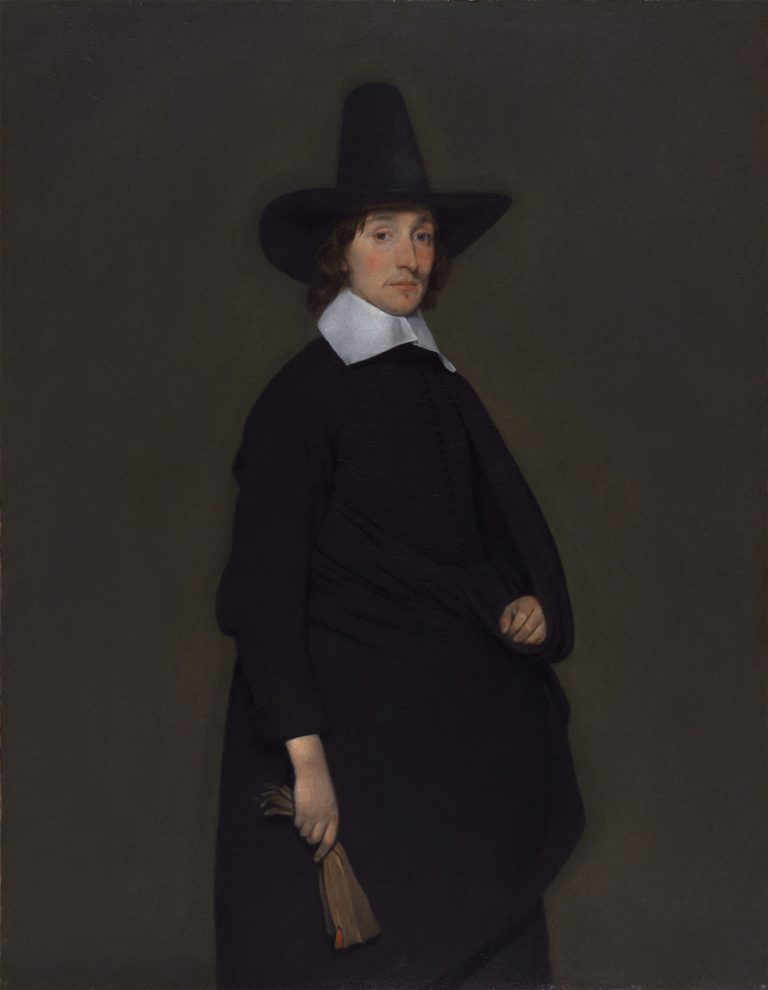Sober in both palette and demeanor, yet steeped in demure charm, these portraits of an unidentified man and woman exemplify the elegant restraint and simplicity of Gerard ter Borch the Younger’s small-scale depictions of prosperous citizens of the Dutch Republic. Isolated before a plain dark-green background, the subjects are visible to knee length; their bodies face three-quarters to center, but their heads are turned to look directly toward the viewer. The man is clad in a black doublet and breeches with a cloak of the same color draped over his left shoulder and wrapped tightly around his middle. The black of his costume and tall “sugarloaf” hat is relieved only by a plain collar of white linen and the tan gloves—with a flash of red lining just barely visible—he grasps loosely in his right hand. The woman’s attire is equally plain: a black gown with a voluminous overskirt tucked up to thigh level. Her sleeve cuffs and broad shoulder kerchief are made of sheer white linen; the cuffs and her underlying chemise are both discreetly trimmed with narrow bands of lace. Personal ornaments are few and modest: a folding fan, a ring, gold earbobs with dangling pearls, and a band of silver lace to edge the crown of her black cap.
Ter Borch’s small-scale portraits cleverly adapted the tradition of grand, full-length state portraits to suit the more modest republican tastes of the Dutch bourgeoisie. Elegant Man and Elegant Woman are typical of those Ter Borch painted for members of Deventer’s political elite around 1660 or slightly later. Most show the sitter at full length, standing stiffly erect before a strikingly spare background furnished (if at all) with just a simple table or chair. Poses are often repeated from one painting to another, either exactly or with trifling variations, such as in the positioning of the hands or in the accessories included. Elegant Man, for example, is virtually identical in pose and costume to the full-length Portrait of a Man in the Alte Pinakothek, Munich (fig 1), while Elegant Woman can be compared to the Portrait of Johanna Quadacker (private collection) or the Portrait of an Older Woman in the Statens Museum for Kunst, Copenhagen (fig 2).1 As Kettering has noted, this uniformity was both intentional and desirable among the close-knit community of Deventer’s elite, who felt a particularly strong sense of civic identity: Ter Borch’s portraits “were designed to reveal a collective identity for sitters whose status within the group . . . mattered nearly as much as their own individuality.”2
Gudlaugsson is of the opinion that these pendant paintings were originally larger and probably depicted the sitters at full length, which seems likely.3 Most of the portraits Ter Borch painted around 1660, including those mentioned above that share these poses, show the subject at full length. Technical evidence does not exclude the possibility that the present paintings have been reduced. The canvases have been lined, the edges of the original canvases are irregularly trimmed, and tacking edges have been removed from all four edges of each canvas. X-radiographs show little evidence of cusping along any of the canvas edges, suggesting that they may have been substantially trimmed on all sides.4 Along the bottom of the woman’s portrait is a 5.5 centimeter-wide horizontal band of slightly darker green background paint; this may be a remnant of the horizontal “shadow” Ter Borch often introduced in his full-length portraits to suggest the transition between wall and floor in an otherwise bare and undefined space. No such band is visible in the portrait of the man, but even in pendant portraits, these shadowy transitions are not always precisely aligned between the two paintings, and one may well have been present below the current bottom edge of the canvas.5
Numerous pentimenti are found in these works, especially in Elegant Man, some of which are visible with the naked eye. Shadowy contours to either side of the man’s figure and around the left, top and right sides of his hat suggest that Ter Borch may originally have planned for a somewhat bulkier figure, or that he re-positioned the figure during the painting process. Similar pentimenti along the woman’s proper left sleeve and the outer contour of her skirt below the fan suggest that her figure, too, was shifted or modified during the painting process. The paintings are generally in good condition, although Elegant Woman contains a patched hole in the canvas (about 3 x 2 cm) just to the left of the sitter’s white collar.6


